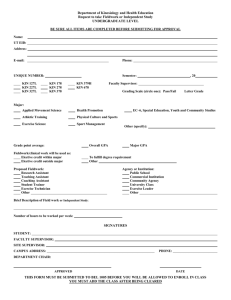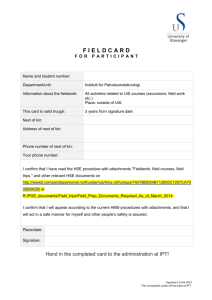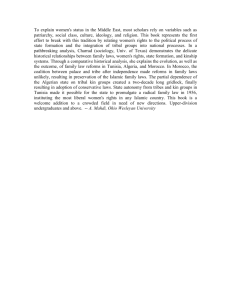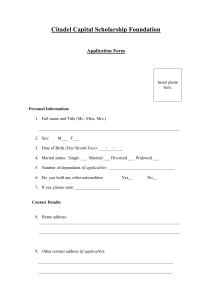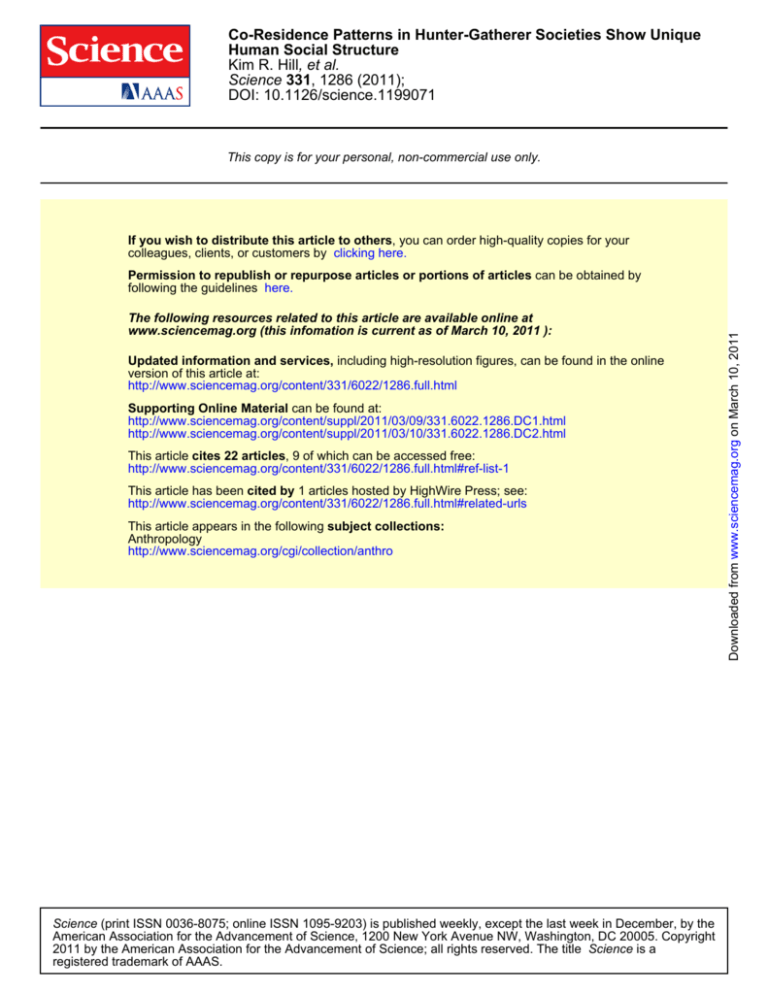
Co-Residence Patterns in Hunter-Gatherer Societies Show Unique
Human Social Structure
Kim R. Hill, et al.
Science 331, 1286 (2011);
DOI: 10.1126/science.1199071
This copy is for your personal, non-commercial use only.
If you wish to distribute this article to others, you can order high-quality copies for your
colleagues, clients, or customers by clicking here.
The following resources related to this article are available online at
www.sciencemag.org (this infomation is current as of March 10, 2011 ):
Updated information and services, including high-resolution figures, can be found in the online
version of this article at:
http://www.sciencemag.org/content/331/6022/1286.full.html
Supporting Online Material can be found at:
http://www.sciencemag.org/content/suppl/2011/03/09/331.6022.1286.DC1.html
http://www.sciencemag.org/content/suppl/2011/03/10/331.6022.1286.DC2.html
This article cites 22 articles, 9 of which can be accessed free:
http://www.sciencemag.org/content/331/6022/1286.full.html#ref-list-1
This article has been cited by 1 articles hosted by HighWire Press; see:
http://www.sciencemag.org/content/331/6022/1286.full.html#related-urls
This article appears in the following subject collections:
Anthropology
http://www.sciencemag.org/cgi/collection/anthro
Science (print ISSN 0036-8075; online ISSN 1095-9203) is published weekly, except the last week in December, by the
American Association for the Advancement of Science, 1200 New York Avenue NW, Washington, DC 20005. Copyright
2011 by the American Association for the Advancement of Science; all rights reserved. The title Science is a
registered trademark of AAAS.
Downloaded from www.sciencemag.org on March 10, 2011
Permission to republish or repurpose articles or portions of articles can be obtained by
following the guidelines here.
Co-Residence Patterns in
Hunter-Gatherer Societies Show
Unique Human Social Structure
Kim R. Hill,1* Robert S. Walker,2* Miran Božičević,1 James Eder,1 Thomas Headland,3,4
Barry Hewlett,5,6 A. Magdalena Hurtado,1 Frank Marlowe,7 Polly Wiessner,8 Brian Wood9
Contemporary humans exhibit spectacular biological success derived from cumulative culture and
cooperation. The origins of these traits may be related to our ancestral group structure. Because
humans lived as foragers for 95% of our species’ history, we analyzed co-residence patterns
among 32 present-day foraging societies (total n = 5067 individuals, mean experienced band
size = 28.2 adults). We found that hunter-gatherers display a unique social structure where
(i) either sex may disperse or remain in their natal group, (ii) adult brothers and sisters often
co-reside, and (iii) most individuals in residential groups are genetically unrelated. These patterns
produce large interaction networks of unrelated adults and suggest that inclusive fitness cannot
explain extensive cooperation in hunter-gatherer bands. However, large social networks may help
to explain why humans evolved capacities for social learning that resulted in cumulative culture.
ur ancestors lived as hunter-gatherers until
the beginning of the Holocene; during
that time, they spread across the globe
and developed features that distinguish us as an
outlier among life forms on this planet (1). Our
biological success appears to be based on both
cooperation with non-kin and exceptional reliance
on cultural transmission, yet critical questions remain about why these traits emerged in humans
but not other animals. Contemporary huntergatherers often show extensive cooperation among
members of a residential unit (referred to here as
a “band”) in ways not paralleled by any other
primate. This includes band-wide food sharing
(2); high levels of allomaternal child care (3); daily
cooperative food acquisition, construction, and
maintenance of living spaces and transportation
of children and possessions (4); and provisioning
of public goods on a daily basis. The widespread
flow of goods and services within hunter-gatherer
bands coevolved with a life history that included
slow juvenile growth, late sexual maturity, high
fertility, high adult survivorship, and a long postreproductive life span (1, 5, 6). The combination
of juvenile allomaternal provisioning, adult shared
energy budgets, and helper-dependent life history
O
1
School of Human Evolution & Social Change, Arizona State
University, Tempe, AZ 85287, USA. 2Department of Anthropology, University of Missouri, Columbia, MO 65211, USA.
3
Department of Anthropology, SIL International, Dallas, TX 75236,
USA. 4Department of Anthropology, Southern Methodist University, Dallas, TX 75275, USA. 5Department of Anthropology,
Hawassa University, Hawassa, Ethiopia. 6Department of Anthropology, Washington State University, Vancouver, WA 98686,
USA. 7Department of Anthropology, Durham University, Durham
DH1 3LE, UK. 8Department of Anthropology, University of Utah,
Salt Lake City, UT 84112, USA. 9Department of Anthropology,
Stanford University, Stanford, CA 94305, USA.
*To whom correspondence should be addressed. E-mail:
kim.hill@asu.edu (K.R.H.); walkerro@missouri.edu (R.W.)
1286
traits has led some to label hunter-gatherers as
cooperative breeders (7, 8).
Evolutionary behavioral scientists have attempted to understand how cooperative temperament might spread in small-scale human societies
and how it might account for “prosocial” and “otherregarding” behaviors (9), exceptional social cognition and shared intentionality (10), orientation
toward teaching and learning (11), a taste for equitable distribution (12), and a widespread willingness to punish norm violators, even when not
directly affected by the noncooperative behavior
(13). These traits appear to be derived in Homo
because they are rare or absent in other apes (14).
If hunter-gatherers engage in extensive cooperation within residential bands, we must determine the composition of these units to assess how
such behavior could have evolved. Traditionally,
anthropologists have suggested that huntergatherer co-residence is almost entirely based on
kinship [e.g., (15, 16)], and evolutionary psychologists have embraced this idea in order to develop
“mismatch hypotheses” about cooperation among
non-kin in modern societies (17). Evolutionary
researchers have also argued both that female
philopatry and maternal grandmother provisioning
is ancestral (5) and that male philopatry, typical
of other African hominoids (18, 19) and leading
to adult male provisioning (8), is the ancestral
human pattern. If either of these is correct, and if
foraging bands are mainly collections of close
kin, inclusive fitness gains might be the primary
motivator of ancestral human cooperation.
Chapais (18) recently developed an alternative
model of ancestral human social structure derived
from pair-bonding and paternal investment within
chimpanzee-like social groups. He suggested that
the affiliation of several unrelated males to the
same female (related as daughter, sister, wife,
son’s wife, or brother’s wife) could ameliorate
11 MARCH 2011
VOL 331
SCIENCE
hostile relations across ancestral male philopatric
groups, and could allow for cross-group visiting
and opportunistic co-residence by kin of either
sex and frequent interactions with affines. This
model predicts lifetime cooperation and frequent
co-residence of adult brothers and sisters as a
unique feature of human society [(18), p. 129].
These features result in metagroups (“tribes”)
composed of multiple residential bands that exchange spouses [(18), pp. 216–228]. Most important, the resultant social structure would lead
to a high number of co-resident adults who are
not genetically related [(18), pp. 235–243]. If this
model is correct, and if most band members are
not closely linked by either kinship or shared genetic descendants, a variety of mechanisms that
promote dyadic and indirect reciprocity (19, 20)
or favor social sanctioning of noncooperators
(21, 22) may be required to explain the emergence of extensive cooperation in ancestral human societies.
Hunter-gatherer residential patterns are also
critical for assessing models of cultural evolution.
If friendly visiting between groups is common
and social network sizes are large, frequent interaction allows for increased observation of rare
innovations that are unlikely to be discovered by
individual learning. Under these conditions, costly
social learning mechanisms are more likely to
evolve (21), and cultural traits are more likely
to accumulate complexity and efficiency (23).
Thus, the emergence of metagroup social structure might explain why humans, but not other
social-learning animals, evolved the cognitive
mechanisms that produce cumulative culture,
and why H. sapiens were able to replace other
hominins as they spread out of Africa (24).
Cross-cultural analysis. We analyzed data
on band composition collected from published
literature and unpublished field notes for a worldwide sample of 32 hunter-gatherer societies (25).
Tabulations of the mean number of primary adult
kin (i.e., parents, siblings, and offspring) that
co-reside in bands clearly support the bisexual
philopatry and dispersal model of co-residence.
We found no significant difference in the mean
number of parents living with adult sons versus
daughters in 19 societies (Table 1). In a minority
of societies, parents were statistically more likely
to co-reside with adult offspring of one sex (seven
societies with sons, six societies with daughters),
but even in these societies many parents lived with
adult offspring of the other sex.
Likewise, adult brothers and sisters frequently
co-reside in all societies; thus, men often co-reside
with male in-laws (fig. S1). In about half of the
societies, men and women lived with no more
same-sex adult siblings than opposite-sex siblings
(table S1, 18 of 32 societies). The pattern of frequent brother-sister co-residence is not just due to
bride service (in which new husbands live with
parents-in-law and work for them) but is evident
across the entire adult life span, even in groups
that show preferential clustering of male kin, and
www.sciencemag.org
Downloaded from www.sciencemag.org on March 10, 2011
RESEARCH ARTICLES
even when controlling for mortality effects by
considering only living siblings (Fig. 1).
Despite the common occurrence of brothersister co-residence, statistical analysis also illustrates a greater tendency for close kin of men to
co-reside than for close female kin to live together. For example, the mean number of adult
brothers residing with each other is significantly
higher than the mean number of adult sisters coresiding in 17 societies, but vice versa in only
three societies (Table 1), and the total number of
co-residing primary kin of males is typically
higher than the number of co-residing primary
kin of females (Table 1 and fig. S1).
The data demonstrate that primary kin associations are typical, but that most adult band members are not close kin in any of the societies in our
sample. The mean total number of co-resident
adult primary kin per band is only 1.8 for these
32 societies (range 0.45 to 5.27, Table 1). This
represents only a small proportion (7%) of the
total co-resident adults in the censused bands
(mean experienced band size = 28.2). To determine exactly who the remaining band members
are, we require complete genealogical and marital information on all adults in the population
(available only for the Ache and Ju/’hoansi).
We analyzed the complete composition of 58
precontact Ache bands (n = 980 adults) using
demographic and marital databases (26), and
one of us (P.W.) tabulated relationships for all
adult dyads in six bands of Ju/’hoansi foragers
(n = 89 adults).
Even though Ache bands are larger than
Ju/’hoansi bands (21 versus 15 adults), typical
band composition from a randomly chosen adult
ego’s point of view shows a common pattern:
First, ego and his/her primary and distant kin connected by up to five meiotic links (genetic coefficient of relatedness r = 1 to 0.03125) make up
only about 25% of the adults who co-reside in
Ache and Ju/’hoansi bands (Fig. 2 and table S2).
Smaller Ju/’hoansi bands contain a greater proportion of primary kin, whereas larger Ache bands
contain a higher proportion of distant kin. Second,
spouse and spouse’s kin constitute about 16% of
the adults in these bands. Thus, primary and distant kin of a family unit make up only about 40%
of the co-resident adult members of a band.
Among the individuals genetically unrelated to
either spouse or ego, the spouses of ego’s primary
kin often carry the same kinship term as spouse’s
primary kin (e.g., brother-in-law, sister-in-law,
etc.) and may be treated equally. These make
up about 6% of adult band members. Other adults
connected through a multiple-linked chain of distant genetic and marriage ties (i.e., “distant affines”
such as cousin’s spouse or “affines of affines” such
as spouse’s brother’s wife’s brother) make up
about half the co-resident adults members of a
band. Finally, about one-quarter of the individuals in a band are not linked directly to ego by
any known genealogical or marriage tie. It is
noteworthy that flexible bilocal residence leads
to neither sex being surrounded mainly by kin
(table S3).
Table 1. Mean number of co-residing adult primary kin for men and women, with societies sorted from most to least virilocal (male-biased) co-residence.
Significant differences were determined by resampling. The mean experienced band size is the mean of all band sizes weighted by the number of individuals who
lived in bands of that size.
Men’s
parents
Women’s
parents
Men’s
brothers
Men’s
sisters
Women’s
brothers
Women’s
sisters
Men’s
primary
kin
Women’s
primary
kin
Mean
experienced
band size
Gunwinggu
Labrador Inuit
Semang
Iglulik
Belcher Island
Mbuti
Hiwi
Angmagsalik
Ainu
Ache
Paliyan
Nunamuit
Aka
Chenchu
Netsilik
Agta
Slavey
Ojibwa
Wanindiljaugwa
Copper
Dogrib
Ju/ ’hoansi
Shoshoni
Batak
Alyawarra
Vedda
Paiute
Apache
Takamiut
Hadza
Hill Pandaram
Miwuyt
1.26*
0.24
0.76*
0.60*
0.15
0.57*
0.54
0.75*
0.15
0.50*
0.28
0.37
0.56
0.44*
0.39
0.35
0.50
0.52
0.07
0.20
0.89
0.71
0.11
0.53
0.57
0.40
0.16
0.49
0.47
0.38
0.16
0.06
0.30
0.14
0.21
0.23
0.10
0.21
0.44
0.20
0.24
0.36
0.16
0.38
0.49
0.25
0.32
0.27
0.46
0.43
0.33†
0.40†
0.94
0.62
0.11
0.53
0.60
0.88†
0.52†
0.56
0.76
0.40
0.50†
0.30†
2.50*
0.36*
0.72*
0.56*
0.50*
0.59*
1.58*
0.25
0.89*
0.59*
0.48*
0.88*
0.51*
0.45*
0.27*
0.42*
1.00
0.78*
1.56
0.33*
1.23
0.37
0.37
0.69
0.65
0.60
0.32
0.29
0.67
0.32
0.16
0.11
0.75
0.18
0.44
0.19
0.45
0.37
0.58
0.25
0.57
0.33
0.57
0.79
0.27
0.40
0.19
0.37
0.29
0.75
1.54
0.13
1.23
0.50
0.24
0.58
0.44
0.30
0.21
0.32
0.33
0.42
0.24
0.22
0.60
0.11
0.46
0.18
0.43
0.33
0.55
0.20
0.53
0.34
0.63
0.75
0.21
0.37
0.18
0.35
0.27
0.71
1.37
0.13
1.16
0.46
0.21
0.73
0.33
0.33
0.21
0.33
0.31
0.38
0.27
0.17
0.60
0.00
0.00
0.13
0.10
0.27
0.51
0.20
0.34
0.16
0.21
0.52
0.33
0.21
0.06
0.27
0.53
0.44
1.46
0.07
1.04
0.31
0.33
0.53
0.88
0.44
0.21
0.48†
0.88
0.68†
0.18
0.42†
5.27*
0.93*
2.40*
1.74*
1.25*
1.88*
3.13*
1.63
1.78*
1.77*
1.57
2.44*
1.86
1.52
1.15
1.42
2.14
2.45*
3.61
0.96
4.20
2.15
0.78
2.25
2.21
1.90
1.03
1.55
2.07
1.43
0.84
0.56
2.20
0.45
1.18
0.97
0.73
1.21
2.05
1.10
1.33
1.36
1.21
2.00
1.55
1.28
0.97
1.22
1.86
2.13
3.16
0.90
4.12
2.14
0.81
2.42
2.43
2.31
1.28
1.96†
2.64
1.93†
1.31†
1.10†
18.0
24.1
19.3
25.5
11.9
32.9
36.7
17.0
14.9
20.7
25.0
64.9
16.6
17.6
17.0
12.8
22.3
56.6
21.4
16.3
81.6
14.5
7.3
42.6
39.2
11.6
11.7
18.6
15.9
35.1
5.8
11.9
Average
0.44
0.39
0.66*
0.45
0.42
0.40
1.93
1.67
28.2
Society
*Significantly more kin co-residing with men (P < 0.05).
Downloaded from www.sciencemag.org on March 10, 2011
RESEARCH ARTICLES
†Significantly more kin co-residing with women (P < 0.05).
www.sciencemag.org
SCIENCE
VOL 331
11 MARCH 2011
1287
RESEARCH ARTICLES
Proportion of siblings co-residing
0.5
A
Women’s brothers
Women’s sisters
Baseline
0.4
0.3
0.2
0.1
0.0
15-21
22-29
30-44
B
45+
Men’s brothers
Men’s sisters
Baseline
0.4
0.3
Fig. 2. Mean band composition from adult ego’s point of view for 58 Ache bands and 6 Ju/’hoansi
bands (data in table S2). The category “distant affines” includes spouses of distant kin, distant kin
of spouse, and affines of affines. The category “No relation” includes all adult dyads that cannot be
connected in five or fewer total steps of kinship and marriage with no more than two marriage links
in the chain of connection. The shaded region shows all band members genetically related to ego.
0.2
0.1
0.0
15-21
22-29
30-44
45+
Age
Fig. 1. Comparison of same-sex and cross-sex
sibling co-residence contingent on survival by age
for precontact Ache women (A) and men (B). Data
points show mean proportions per age group of
surviving siblings who co-reside. Bars indicate 95%
confidence intervals; triangles mark the baseline
proportion of co-residence for all adults in the population who are more than three genealogical steps
removed (and not married to each other). Brotherbrother and brother-sister co-residence is common throughout the life span, but after their 30s,
women are no more likely to co-reside with another
living sister than with any randomly selected, unrelated adult.
Conclusion. Formerly, anthropologists believed
that hunter-gatherers lived in patrilocal bands
composed mainly of close kin (15). Here, we
present a statistical analysis of hunter-gatherer
band composition based on actual residence
rather than cultural rules. We show that bisexual
philopatry and dispersal are typical and result in
frequent adult brother-sister co-residence. This
social pattern is not reported for any other primate or vertebrate, as far as we know. We hypothesize that monogamous pair bonding, paternal
recognition within cooperatively breeding social
units (8), and bisexual dispersal facilitate frequent
and friendly intergroup relations (18) and migration and low group genetic relatedness of band
co-residents.
The hunter-gatherer social structure we describe has important implications for theories
about the evolution of cooperation and cultural
capacity. First, bands are mainly composed of
individuals either distantly related by kinship
and/or marriage or unrelated altogether. In our
sample of 32 societies, primary kin generally make
up less than 10% of a residential band. For example, in the Ache we estimate the mean genetic
coefficient of relatedness (Hamilton’s r) between
1288
adults in 58 precontact bands to be only 0.054 (n =
19,634 dyads, SE = 0.0001). This agrees with
Ache informants who reported that during the
precontact period they often lived with people
described as “friends, not relatives.” The Ju/’hoansi
results in Fig. 2 suggest that mean relatedness in
other groups is not too different from the Ache.
Thus, we cannot necessarily assume that cognitive features such as inequality aversion and enhanced prosocial emotions evolved in ancestral
environments composed mainly of close kin.
Given the constant flow of individuals between
groups, genetic group selection at the level of the
band also seems improbable. Instead, cultural
group selection (27) may lead to the spread of
cooperative institutions within ethnic groups,
which might then create a context favoring the
genetic evolution of prosocial cognitive mechanisms through individual-level selection.
Second, mathematical models suggest that
large interaction networks may be required for
culture to accumulate (21, 23). In small populations, cultural innovations can be lost because
of infrequent interaction between potential models and imitators and/or stochastic events that
eliminate models with particular cultural knowledge. For example, one of the authors (K.R.H.)
observed that the Northern Ache, isolated from
their ancestral core territory in the 19th century,
were unable to make fire by the time they were
contacted in the 1970s. However, older informants
stated that their parents and grandparents had told
them that their ancestors could make fire, and had
partially described to them the technique, even
though none had ever observed it directly. In contrast, the Southern Ache groups did maintain firemaking knowledge until their first contact in the
late 20th century. Likewise, Tasmanians failed to
maintain previously known methods for fishing
when their island was cut off from mainland
Australia in the early Holocene (23), and fishing
technology in Polynesia shows reduced complexity
11 MARCH 2011
VOL 331
SCIENCE
on islands with smaller populations (28). In
contrast, Wiessner [(29) and references therein]
conducted studies on style and social information
in material culture among Kalahari Bushman
bands from four language families connected by
intermarriage, exchange partnerships, and visiting.
She found that tapered bone points were rapidly
replaced everywhere by iron tips when fence wire
became available in the 20th century, and that new
point styles emerged and became relatively homogeneous within language groups over a period of
40 years.
When people reside together, they have frequent opportunities to observe innovations, evaluate their success, and imitate traits judged most
successful or most common. Our analyses suggest
that the increased network size that follows a
unique shift in ancestral human residential structure may have led to greater exposure to novel
ideas worth copying, and may explain why humans, but not other animals, evolved costly social
learning mechanisms (such as high-fidelity overimitation or conformity-biased transmission) that
may have resulted in cumulative cultural evolution (21). This unique expansion of network size
in our hominin ancestors can be detected archaeologically by the emergence of long-distance
flows of tools and raw materials that appear at
least as early as the middle Pleistocene (30).
The extent to which modern hunter-gatherer
patterns represent ancestral patterns is a complex
question. For example, most of our sample societies were censused after the elimination of warfare, and many had been geographically displaced
or lived in environments that had been substantially depleted of large game. All modern
hunter-gatherers use projectile weapons that were
not available to our distant ancestors. Without
causal models of residential association that consider the impacts of technology, warfare, cooperative hunting, territorial inheritance, depletion, and
demographic crashes, we should be cautious about
www.sciencemag.org
Downloaded from www.sciencemag.org on March 10, 2011
Proportion of siblings co-residing
0.5
RESEARCH ARTICLES
References and Notes
1. K. Hill, M. Barton, A. M. Hurtado, Evol. Anthropol. 18,
187 (2009).
2. M. Gurven, Behav. Brain Sci. 27, 543 (2004).
3. P. K. Ivey, G. A. Morelli, E. Z. Tronick, in Hunter-Gatherer
Childhoods: Evolutionary, Developmental and Cultural
Perspectives, B. Hewlett, M. Lamb, Eds. (Aldine de Gruyter,
New York, 2005), pp. 191–213.
4. K. Hill, Hum. Nat. 13, 105 (2002).
5. K. Hawkes, J. F. O’Connell, N. G. Jones, H. Alvarez, E. L.
Charnov, Proc. Natl. Acad. Sci. U.S.A. 95, 1336 (1998).
6. H. S. Kaplan, K. R. Hill, J. B. Lancaster, A. M. Hurtado,
Evol. Anthropol. 9, 156 (2000).
7. S. B. Hrdy, Mothers and Others (Belknap, Cambridge,
MA, 2009).
8. K. R. Hill, A. M. Hurtado, Proc. Biol. Sci. 276, 3863 (2009).
9. C. F. Camerer, E. Fehr, Science 311, 47 (2006).
10. E. Herrmann, J. Call, M. V. Hernàndez-Lloreda, B. Hare,
M. Tomasello, Science 317, 1360 (2007).
11. G. Csibra, Trends Cogn. Sci. 11, 95 (2007).
12. E. Fehr, H. Bernhard, B. Rockenbach, Nature 454,
1079 (2008).
13. J. Henrich et al., Science 312, 1767 (2006).
14. J. B. Silk, Science 311, 1248 (2006).
15. E. Service, Primitive Social Organization (Random House,
New York, 1962).
16. J. Helm, in Man the Hunter, R. B. Lee, I. DeVore, Eds.
(Aldine, Chicago, 1968), pp. 118–139.
17. M. Chudek, W. Zhao, J. Henrich, in Signaling,
Commitment, and Emotion, R. Joyce, K. Sterelny,
B. Calcott, Eds. (MIT Press, Cambridge, MA, 2010),
pp. 1–24.
18. B. Chapais, Primeval Kinship: How Pair-Bonding Gave
Birth to Human Society (Harvard Univ. Press, Cambridge,
MA, 2008).
19. W. Allen-Arave, M. Gurven, K. R. Hill, Evol. Hum. Behav.
29, 305 (2008).
20. K. Panchanathan, R. Boyd, Nature 432, 499 (2004).
Ordered and Dynamic Assembly
of Single Spliceosomes
Aaron A. Hoskins,1,2 Larry J. Friedman,2 Sarah S. Gallagher,3* Daniel J. Crawford,1,2
Eric G. Anderson,1 Richard Wombacher,3† Nicholas Ramirez,1‡ Virginia W. Cornish,3
Jeff Gelles,2§ Melissa J. Moore1§
The spliceosome is the complex macromolecular machine responsible for removing introns from
precursors to messenger RNAs (pre-mRNAs). We combined yeast genetic engineering, chemical
biology, and multiwavelength fluorescence microscopy to follow assembly of single spliceosomes
in real time in whole-cell extracts. We find that individual spliceosomal subcomplexes associate
with pre-mRNA sequentially via an ordered pathway to yield functional spliceosomes and that
association of every subcomplex is reversible. Further, early subcomplex binding events do not fully
commit a pre-mRNA to splicing; rather, commitment increases as assembly proceeds. These
findings have important implications for the regulation of alternative splicing. This experimental
strategy should prove widely useful for mechanistic analysis of other macromolecular machines
in environments approaching the complexity of living cells.
he spliceosome is a complex macromolecular machine responsible for removing introns from nascent transcripts via
pre-mRNA (precursor to mRNA) splicing (1). The
spliceosome is composed of five small nuclear
RNAs (snRNAs) and ~100 core proteins minimally required for activity in vitro (2). The snRNAs
T
1
Department of Biochemistry and Molecular Pharmacology,
Howard Hughes Medical Institute, University of Massachusetts
Medical School, Worcester, MA 01605, USA. 2Department of
Biochemistry, Brandeis University, Waltham, MA 02454, USA.
3
Department of Chemistry, Columbia University, New York, NY
10027, USA.
*Present address: Environmental Protection Agency, Washington,
DC 20004, USA.
†Present address: Institute of Pharmacy and Molecular Biotechnology, Heidelberg University, Heidelberg D-69120,
Germany.
‡Present address: Department of Molecular and Cellular Biology, Harvard University, Cambridge, MA 02138, USA.
§To whom correspondence should be addressed. E-mail:
gelles@brandeis.edu (J.G.); melissa.moore@umassmed.edu (M.J.M.)
and many core proteins are arranged into stable
subcomplexes constituting small nuclear ribonucleoprotein particles [U1 and U2 small nuclear
ribonucleoproteins (snRNPs) and the U4/U6.U5
tri-snRNP] and the multiprotein Prp19-complex
(NTC). Although association of U1 with premRNA can occur in the absence of adenosine
triphosphate (ATP), stable association of all other
subcomplexes requires ATP hydrolysis. Intron
excision occurs after the spliceosome has been
fully assembled and activated by additional structural rearrangements (3).
Current models of spliceosome assembly, activation, and catalysis generally depict it as an
ordered (U1 → U2 → tri-snRNP → NTC →
activation → catalysis), one-way process (3). Yet
deviations from the ordered assembly model
have been reported (4–6), with some studies suggesting that both spliceosome assembly and catalysis are dynamic and reversible (7–9). None of
these studies, however, directly examined the ki-
www.sciencemag.org
SCIENCE
VOL 331
21.
22.
23.
24.
25.
26.
27.
28.
29.
30.
31.
R. Boyd, P. J. Richerson, Proc. Br. Acad. 88, 77 (1996).
R. Boyd, S. Mathew, Science 316, 1858 (2007).
J. Henrich, Am. Antiq. 69, 197 (2004).
A. Powell, S. Shennan, M. G. Thomas, Science 324, 1298
(2009).
See supporting material on Science Online.
K. Hill, A. M. Hurtado, Ache Life History: The Ecology and
Demography of a Foraging People (Aldine, New York, 1996).
R. Boyd, P. J. Richerson, J. Theor. Biol. 215, 287 (2002).
M. A. Klein, R. Boyd, Proc. Biol. Sci. 277, 2559 (2010).
P. Wiessner, Am. Antiq. 48, 253 (1983).
S. Mcbrearty, A. S. Brooks, J. Hum. Evol. 39, 453 (2000).
We thank each of our study populations for cooperation
with data collection, W. Denham for compiling the
GCBS database, and B. Chapais, M. Flinn, P. Gardner,
M. Gurven, and N. Peterson for discussions.
Supporting Online Material
www.sciencemag.org/cgi/content/full/331/6022/1286/DC1
Materials and Methods
SOM Text
Figs. S1 to S12
Figs. S1 to S3
References
14 October 2010; accepted 18 January 2011
10.1126/science.1199071
netics of subcomplex association with pre-mRNA.
We monitored subcomplex dynamics during spliceosome assembly in real time by combining yeast
genetic engineering, chemical biology, and a multiwavelength fluorescence technique, colocalization
single-molecule spectroscopy (CoSMoS) (10).
Labeling spliceosome subcomplexes. We
previously established that splicing of single premRNA molecules can be monitored by multiwavelength total internal reflection fluorescence
(TIRF) microscopy in the complex environment
of Saccharomyces cerevisiae whole-cell extract
(yeast WCE) (11). To enable kinetic analysis of
spliceosome assembly, we have now developed
methods to introduce fluorophores into individual spliceosomal subcomplexes in WCE. Protein
labeling was accomplished using homologous
recombination to fuse either a SNAP (an alkylguanine S-transferase) (12) or an Escherichia
coli DHFR (dihydrofolate reductase) tag (13)
onto the C terminus of numerous spliceosomal
proteins. These tags enabled us to incorporate
bright, photostable organic dyes into the subcomplexes and to avoid the poor photon output
and blinking behavior of single fluorescent proteins (14). Integration of two orthogonal tags allows for simultaneous monitoring of two different
subcomplexes by CoSMoS (Fig. 1). To ensure
functionality of the tagged species, we tagged
only essential proteins and verified that the resultant strains (table S1) had growth rates and in
vitro splicing activities comparable to the parental strain (figs. S1 to S3). By using several
selectable markers, we were able to incorporate
up to three tags into a single strain. Multiple tags
present in the same subcomplex minimized artifacts due to incomplete labeling, photobleaching, and/or long-lived dark-state formation of
single fluorophores (15).
DHFR tags were labeled by adding excess
(20 nM) fluorophore-trimethoprim (TMP) con-
11 MARCH 2011
Downloaded from www.sciencemag.org on March 10, 2011
the use of specific modern groups as analogs for
past patterns. Nonetheless, the robustness of our
main result suggests that our foraging ancestors
evolved a novel social structure that emphasized
bilateral kin associations, frequent brother-sister
affiliation, important affinal alliances, and coresidence with many unrelated individuals. How
this social structure evolved, and how it in turn
affected cooperation and cultural capacity—and
the role of language in all these features—are
key to understanding the emergence of human
uniqueness.
1289

